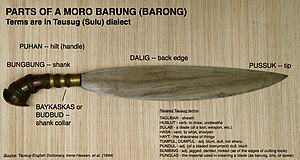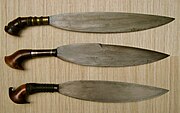A sword is an edged, bladed weapon intended for manual cutting or thrusting. Its blade, longer than a knife or dagger, is attached to a hilt and can be straight or curved. A thrusting sword tends to have a straighter blade with a pointed tip. A slashing sword is more likely to be curved and to have a sharpened cutting edge on one or both sides of the blade. Many swords are designed for both thrusting and slashing. The precise definition of a sword varies by historical epoch and geographic region.

The hilt of a knife, dagger, sword, or bayonet is its handle, consisting of a guard, grip and pommel. The guard may contain a crossguard or quillons. A tassel or sword knot may be attached to the guard or pommel.
The yatagan, yataghan or ataghan, also called varsak, is a type of Ottoman knife or short sabre used from the mid-16th to late 19th centuries. The yatagan was extensively used in Ottoman Turkey and in areas under immediate Ottoman influence, such as the Balkans and the Caucasus.

The kampilan is a type of single-edged sword, traditionally used by various ethnic groups in the Philippine archipelago. It has a distinct profile, with the tapered blade being much broader and thinner at the point than at its base, sometimes with a protruding spikelet along the flat side of the tip. The design of the pommel varies between ethnic groups, but it usually depicts either a buaya (crocodile), a bakunawa, a kalaw (hornbill), or a kakatua (cockatoo)..

The talwar, also spelled talwaar and tulwar, is a type of curved sword or sabre from the Indian subcontinent.
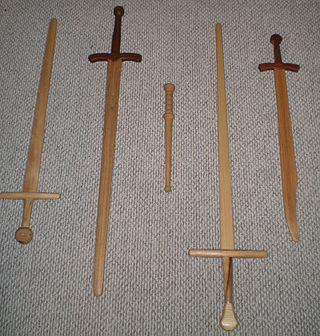
In martial arts, a waster is a practice weapon, usually a sword, and usually made out of wood, though nylon (plastic) wasters are also available. Nylon being much safer than wood, due to it having an adequate amount of flex for thrusts to be generally safe, unlike wooden wasters. Even a steel feder has more flex than most wooden wasters. The use of wood or nylon instead of metal provides an economic option for initial weapons training and sparring, at some loss of genuine experience. A weighted waster may be used for a sort of strength training, theoretically making the movements of using an actual sword comparatively easier and quicker, though modern sports science shows that an athlete would most optimally train with an implement which is closest to the same weight, balance, and shape of the tool they will be using. Wasters as wooden practice weapons have been found in a variety of cultures over a number of centuries, including ancient China, Ireland, Iran, Scotland, Rome, Egypt, medieval and renaissance Europe, Japan, and into the modern era in Europe and the United States. Over the course of time, wasters took a variety of forms not necessarily influenced by chronological succession, ranging from simple sticks to clip-point dowels with leather basket hilts to careful replicas of real swords.

Seax is an Old English word for "knife". In modern archaeology, the term seax is used specifically for a type of small sword, knife or dagger typical of the Germanic peoples of the Migration Period and the Early Middle Ages, especially the Saxons, whose name derives from the weapon. These vary considerably in size.

Japanese sword mountings are the various housings and associated fittings that hold the blade of a Japanese sword when it is being worn or stored. Koshirae (拵え) refers to the ornate mountings of a Japanese sword used when the sword blade is being worn by its owner, whereas the shirasaya is a plain undecorated wooden mounting composed of a saya and tsuka that the sword blade is stored in when not being used.

The shashka or shasqua, is a kind of sabre; a single-edged, single-handed, and guardless backsword. In appearance, the shashka is midway between a typically curved sabre and a straight sword. It has a slightly curved blade, and can be effective for both cutting and thrusting.

A kalis is a type of double-edged Philippine sword, often with a "wavy" section. The kalis has a double-edged blade, which is commonly straight from the tip but wavy near the handle. Kalis with fully straight or fully wavy blades also exist. It is similar to the Javanese keris, but differs in that the kalis is a sword, not a dagger. It is much larger than the keris and has a straight or slightly curved hilt, making it primarily a heavy slashing weapon.

The Model 1832 foot artillery sword was a 25-inch (64 cm) short-sword with a straight, double-edged blade and brass-mounted leather scabbard.

Dha is the Burmese word for "knife" and "sword" similar term to daab or darb in Thai language for a single edge sword. The term dha is conventionally used to refer to a wide variety of knives and swords used by many people across Southeast Asia, especially present-day Myanmar (Burma), Thailand, Yunnan, Laos, Cambodia and Vietnam.

The Wallace Sword is an antique two-handed sword purported to have belonged to William Wallace (1270–1305), a Scottish knight who led a resistance to the English occupation of Scotland during the Wars of Scottish Independence. It is said to have been used by William Wallace at the Battle of Stirling Bridge in 1297 and the Battle of Falkirk (1298).

The panabas, also known as nawi, is a large, forward-curved sword or battle axe used by certain ethnic groups in the southern Philippines. It can range in size from 2 to 4 feet and can be held with one or both hands, delivering a deep, meat cleaver-like cut. In its heyday, it was used as a combat weapon, as an execution tool, and as a display of power. Occasional use as an agricultural and butchering tool has also been noted.
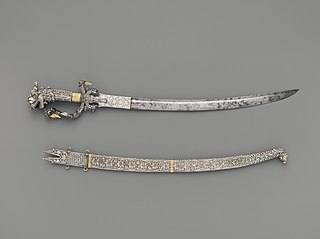
A kasthane is a short traditional ceremonial or decorative single-edged Sri Lankan sword. The sword is featured in the Flag of Sri Lanka.
The Moplah sword is a sword used by the Muslim population in the Malabar Coast in southwestern India.

Balato is a sword that originates from Nias, an island off the west coast of North Sumatra, Indonesia.
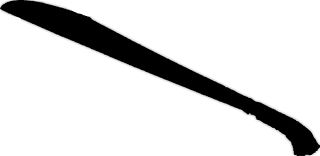
The bangkung or bangkon, is a short sword originating in the Sulu Archipelago of the Philippines. The bangkung was used primarily by the Moro people of the Sulu and is not associated with Moros in other areas such as Mindanao, although it is sometimes found in coastal regions. The bangkung is a slashing weapon, meant to deliver hacking type blows. While the bangkung is a very effective sword, it was not popular unlike the panabas and the pirah and for this reason it is one of the most rarely found Moro edged weapons. Few were produced and even fewer survive.
The Pattern 1831 sabre for General Officers is a British army pattern sword prescribed for the use of officers of the rank of major-general and above. It has been in continuous use from 1831 to the present. It is an example of a type of sword described as a mameluke sabre.
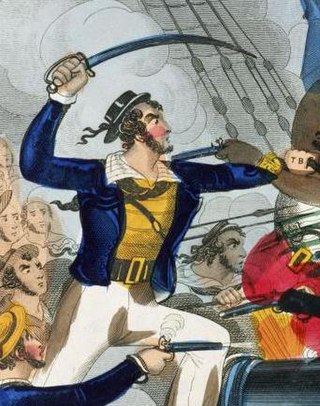
Ratings of the Royal Navy have used cutlasses, short, wide bladed swords, since the early 18th century. These were originally of non-uniform design but the 1804 Pattern, the first Navy-issue standard cutlass, was introduced at the start of the 19th century. This was a bluntish weapon that was perhaps intended for cutting away canvas and ropes rather than as a thrusting combat weapon. The 1845 Pattern cutlass introduced a bowl-style hand guard which provided greater protection, with a longer and more curved blade. Its sharper point made it more useful for thrusting attacks, which were now emphasised in the drill manual. The 1845 Pattern was modified several times including shortening and straightening the blades, which weakened them. The 1889 Pattern had a straight, spear-pointed blade with a hilt that curved outwards to catch and redirect an opponent's sword point. The 1900 Pattern, the last navy-issue cutlass, was similar to its predecessor with the introduction of a fuller and a hilt insert that cushioned the user's little finger. The cutlass was withdrawn from service in 1936 but remains in use for ceremonial purposes. It is thought that it was last used in combat in 1900 during the Boxer Rebellion.
